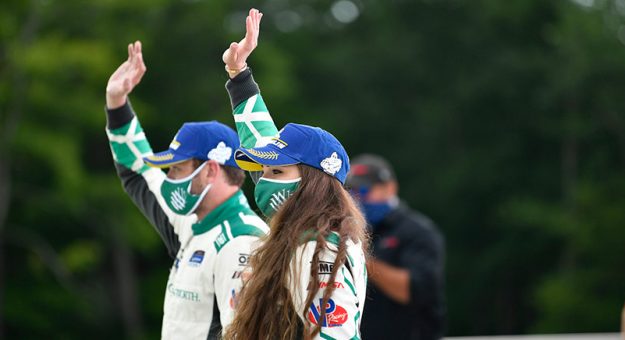By Jeff Olson
The crash was frighteningly violent. A blue-and-white Lamborghini barreled through the famous corkscrew at WeatherTech Raceway Laguna Seca, slammed nose-first into a tire barrier and flipped before landing on its wheels in a shower of gravel. The video replay of the incident went beyond the motorsports world; various replays of it on YouTube have been viewed more than 800,000 times.
It also marked the start of Sheena Monk’s exceptional story of determination, recovery and triumph. Seven months to the day after sustaining nine painful fractures in the September 2018 crash, she was back in a race car at Barber Motorsports Park, warily watched by nervous doctors, beginning a momentous comeback.
“It was against doctors’ orders,” Monk explained. “I still had very fragile pelvic fractures. I had four pelvic fractures, a broken sacrum and four broken ribs. The pelvic fractures in particular were still very fragile. It was a little bit contentious on my end. They gave me the approval, but they said, ‘Look, if you get in an accident, it can change your life.’”
Instead of an accident changing her life, victory did. Less than two years after the crash, Monk was celebrating victory. On Aug. 1, she teamed with Corey Lewis to win the IMSA Michelin Pilot Challenge race at Road America in the No. 3 Motorsports In Action McLaren 570S GT4.
The goals are clear and attainable — a ride in the IMSA WeatherTech SportsCar Championship and maybe, just maybe, a shot at the 24 Hours of Le Mans some day — for the 31-year-old from Newtown, Pennsylvania.
“I’m still climbing this ladder, and it’s a big ladder,” Monk said. “I know where I want to get, and that never changed because of a singular moment.”
Monk found victory by adapting quickly and applying her familiarity of Road America. She’d raced and tested at the 14-turn, 4.048-mile circuit numerous times in the past, but a July 31 practice session was her first at the track in the McLaren.
“My first session out was very strange for me,” she said. “You have to drive the McLaren pretty gently in order for it to give you more. I’m used to driving a Lamborghini, where you really have to go as deep as you can into the brake zone and you’re putting your whole leg into the brake. The McLaren doesn’t like that. The McLaren wants you to brake a smidge earlier and be soft, actually. The McLaren likes you to dance with it and be smooth.”
So, in the middle of the session, Monk had a conversation with herself.
“I said, ‘OK, you’ve got to stop doing that,” she said. “I could feel the car was unhappy doing that. I literally had to flip a switch and say, ‘You know the track, but you need to accommodate what this car prefers.’ This was the third place we’d been with the McLaren, but this was the first place I’d been that I had driven in another car. … That was the first time that I’d encountered having to hit the reset button and figure out how to drive this one.”
Monk grew up around motorized vehicles and karting. In 2017, she completed the Lamborghini Corso Pilota school, then moved to the Lamborghini Super Trofeo North American Series where she finished third in class in her debut at the World Final in Imola, Italy. Accommodating and adapting are skills she learned at an early age.
“We always had fast cars in the family,” Monk said. “I got a go-kart as a kid, but it was an off-road go-kart. I got that when I was 5, and then I got a dirt bike when I was 7. It’s something that I always had been around. The opportunity wasn’t there until I was a little older, but I always grew up as a gearhead. It wasn’t until I was older that I realized that it was a path I wanted to take and the opportunity was there.”
Opportunities exist for women in IMSA – not just as drivers, but as engineers, executives and a variety of other roles – but Monk would like to speed up the process.
“It’s a generational thing,” she said. “If we shift the priorities now, then I think you’ll start to see in a couple of years where that benefit is paying off. Beyond drivers, I would love to see more interest in STEM programs and more female engineers. I’ve been fortunate enough to work with a couple, but I don’t think there are quite enough yet. It will take time to see that trickle-down effect and the interest to catch on.”
In the meantime, she’ll keep chasing victory and her personal comeback story, with her eyes on the next rung of the ladder, with persistence on her side, with a story that resonates.
“There are a lot of big names in the paddock, and I’m kind of a nobody in terms of those names,” Monk said. “But it’s important to show people that if you want something bad enough, you can attain it. Setbacks happen, but you can still do something great afterward. There’s still greatness beyond bad things.
“It took a lot of time. It took almost two years, but I stood at the top again. I did that with the help of a lot of other people. You can do great things after something bad happens to you. You just have to keep your head down and know what you want. I think there’s something that everybody can take from that.”
